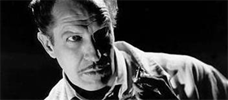Reviews
Roger Corman
USA, 1964
Credits
Review by Michael Nordine
Posted on 27 June 2011
Source Netflix Instant
Related articles
Reviews
The Tomb of Ligeia by Matt
Categories Vincent Price
Nor lie in death forever
Roger Corman directed eight adaptations of stories by Edgar Allan Poe between 1960 and 1964, all but one of which starred Vincent Price. Purveyor of gallows humor and sardonic wit that Price was, this comes as little surprise. Here and elsewhere, he not only satisfies but exemplifies Poe’s poetically morbid sensibilities. As The Tomb of Ligeia’s widower-baron Verden Fell, Price, at various points throughout the film, recites an encyclopedic definition of the fox when presented with a dead specimen; wears sunglasses to shield his deathly sensitive eyes from the sun; and stands defiant in the face of god and the church in the mere act of burying his unchristian wife. “It is my ground,” he says in his trademark deadpan when told by the priest presiding over the ceremony that the corpse of his recently-deceased wife Ligeia is unfit for god’s soil in the opening scene. But here, unlike many of his other films, Price isn’t the man behind the curtain he thinks himself to be—he’s a husband driven mad by love and wedded to tragedy. This dual role of deluded instigator and victim suits Price well: it allows for a more three-dimensional performance as saturated in grief as it is built on scheming.
If both Poe’s oeuvre itself and the many works based on it can be roughly divided between the melancholic and the chilling (with no small amount of overlap), then The Tomb of Ligeia falls somewhere on the mournful side of the spectrum. This shouldn’t suggest that the film is without its intended haunts - few of which, if we’re being honest, elicit much in the way of genuine fear - but the source material itself is unusual among Poe’s output for how much of it takes place in daylight. Corman and screenwriter Robert Towne (best known for penning Chinatown) build their 18th century mise-en-scène not only on doom and gloom but also on cheerful orchestral odes and fox hunts through the countryside that just happen to lead to the graveyard. Moreover, the story has been interpreted by some as the opium dream of an unreliable narrator. This aspect of the text isn’t explicitly touched on in Corman’s film, but it’s fascinating for the way it both muddles and clarifies the strange goings on. The formal, even stilted milieu of the 18th century-set story is highly conducive to the occult. Here and elsewhere Poe shows a love of pairing the stately with the supernatural, almost always toward the end of portraying one as stifling and the other as liberating—even and especially when it’s terrifying. To have one’s pulse race when turning the pages of “Ligeia” - or, indeed, while watching Corman’s film - isn’t merely to fall into Poe’s literary trap, it’s to somehow be in communion with the dead author.
Rather than Price, the film finds its embodiment of terror in the black cat who may or may not contain Ligeia’s soul. The cat appears sporadically and never remains in sight for long. It carries with it a sense of dread, linked as it is to the mysteries of death, but also of possibility: Corman neither confirms nor denies this suspicion. Though Verden is exceedingly attuned to the supernatural, not even he suspects what the cat’s true nature may be until all other possibilities are exhausted. The Tomb of Ligeia’s largest flaw may be that Corman is more apt at establishing his setpieces than he is at moving them across the board, but here it works the other way around: the less Corman focuses on the cat, the more its enigma grows.
Not long into the film, Verden interprets the removal of Ligeia’s date of death from her headstone as a prophecy of her return. It’s here that his affinity for archaeology and dead civilizations is most important. Verden has many Egyptian relics strewn about his abbey-tomb of a home; he’s something of an expert on the ancient civilization and finds much significance in their use of, and engravings on, stone tablets. (His amateur Egyptology also underlines the importance of the cat.) It’s Ligeia whom he loves, Ligeia whom he considers above mortality, and he awaits her return the way a farmer waits for rain. Verden finds what he considers to be the reincarnation of Ligeia in a woman named Rowena. The completion of this transformation - first through a trance-like ceremony and then in an extended dream sequence that seems especially opium-induced - is an involuntary process forced on Rowena from without. “We all hunt for different things in our lives, Baron,” Verden is told by a friend. The price we’re willing to pay for our what we want most is one of Tomb of Ligeia’s primary subjects, and Verden becomes a tragic character simply by having a will as strong as his desire.
Corman’s take on Ligeia, though lacking the cloud of opium that may have birthed the original text, maintains the same incorporeal sense of wonder and dismay. It was the last of his eight Poe adaptations, but at no point does it strike a note of finality. Given its focus on the cyclical nature of death and rebirth, this may have been inevitable, but so, too, is it wholly apropos of Poe himself: death is rarely the end in his stories. He more often uses the departure from this mortal coil as the start of something new, something few others have shown the same talent for conveying—or even dreaming up in the first place.
More Vincent Price
-

The Tingler
1959 -

The Masque of the Red Death
1964 -

The Last Man on Earth
1964 -

The Tomb of Ligeia
1964 -

War-Gods of the Deep
1965 -

Witchfinder General
1968 -

More Dead Than Alive
1969 -

The Abominable Dr. Phibes
1971 -

Dr. Phibes Rises Again!
1972 -

Theatre of Blood
1973
We don’t do comments anymore, but you may contact us here or find us on Twitter or Facebook.



